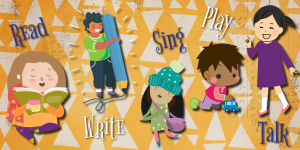
Print awareness (sometimes called print conventions) includes knowing how to handle a book and noticing print all around us. It also includes recognizing that print has meaning, that it stands for words that can represent real things.
Researchers have shown that these skills are fundamental to leaning how to read later on. You can help your children build their print awareness as you read with them every day!
Babies
- Reading sturdy board books or other durable books is good because your baby probably treats books as they would any other toy—as a plaything! Letting your baby explore books in this way—even if it includes chewing on the cover—helps them learn how books work.
- Babies like books with pictures of familiar things and faces. You can read a book about something familiar, like fruit, then get a real piece of fruit to show your baby. By showing your baby the real item, you are helping them realize that pictures represent real things. Later on, they will understand that print represents real things, too.
- Let your baby turn the pages of the book you are reading, even if takes more time to finish the story. Helping them become comfortable with turning pages and seeing how the book works is an important first step of print awareness.
Toddlers
- When you are reading with your children, run your finger under the words, especially of a title or repeated phrase. This helps them understand that you are not reading the pictures; you are reading the text. For example, if you are reading a picture book with the word “dog” in it, underline the word “dog” with your finger as you say the word, so your toddler will know you are reading the word “dog,” not just seeing the picture on the page.
- When we do things like make and read a grocery list, children can see that print has a purpose. Encourage your children to collaborate with you as you read your grocery list, or to read you one of their own.
- We see print all around in every day. It can be on t-shirts, signs, soup cans, shampoo bottles, and more. This is called environmental print. Encourage your children to notice environmental print like this, whether it is on a stop sign or a sign for their favorite fast food restaurant. They are “reading” the sign!
Brown Bear, Brown Bear, What Do You See?
Preschoolers
- Part of print awareness is recognizing that print has meaning. The size of a book’s font is sometimes used in a clever way to add meaning to a story. For example, in Mo Willem’s Elephant and Piggie books, you can often tell when a character is speaking or YELLING based on the size of the font or the use of uppercase letters. As you read books like this together, talk about how you might notice cues like this to help you understand how to read the words.
- Every now and then when you are reading with your children, turn the book upside down or backwards. See if they notice that you are holding it the wrong way. Knowing how to hold a book is a part of print awareness. You can also point out the different parts of a book as you read together—from the front cover and the title page to the index and author’s biography.
- Children can learn the connection between written and spoken word through making their own books of stories. Write down your children’s story as they tell it to you. You can staple it into a book for them, then take turns reading the book to each other.
-Kelly, Children's Librarian, Joel D. Valdez Main Library
Source
 Read, Write, Talk, Sing, Play!
Read, Write, Talk, Sing, Play!
Reading helps children understand how text works and positions them to increase their language and literacy skills throughout their lives.
Read more about early literacy and how you can make a difference in your child's life.


